Your cart is empty
PRESENTED BY Mystery Ranch
WORDS BY Lindsey Davis | PHOTOS BY Tyler Sharp
ORIGINALLY PUBLISHED IN MODERN HUNTSMAN, VOLUME FOUR: THE WOMEN’S ISSUE
Check out our favorite Mystery Ranch Pack:
On a very normal winter day at home in Salt Lake City, I got a call from Ryan Holm over at Mystery Ranch. We’d originally met a few years ago, and I knew he was one of the few folks in the industry with passions that spanned the hunting and outdoor sector, and was working hard to communicate the values of each community. He’d been keeping tabs on my journey as a hunter, and knew I was working up to my first archery season. Ryan had a vision for a hunt using only sticks and strings — traditional bow hunting — and for some reason, he thought to include me. After our call, I nearly leaped out of my boots at the opportunity he’d presented me with: to learn how to shoot traditional bows together over the next six months, and test our skills on a mule deer hunt on the American Prairie Reserve in central Montana. It had always been a part of my grand plan as a hunter to work my way into bow hunting. For beginners who didn’t grow up familiar with guns, there is something about it that seems a bit more approachable, and even romantic. However, I knew, ethically speaking, that I needed to first learn with a rifle. You see, with abow, it is a much different dance with an animal. It requires close range, and has less knock-down power, so it’s important to know exactly what you’re doing. I had hoped that after three seasons of dedicating myself to rifle hunting, I’d have enough of a foundation established to start bowhunting. The timing of this call from Ryan was somewhat fortuitous, as it was my fourth season and I’d won a special permit in Utah that allowed me to hunt the bow, muzzleloader and rifle seasons. This way, I could tip-toe into archery, and have rifle season to fall back on if I didn’t get an opportunity with the bow, or trust my shot in the moment.
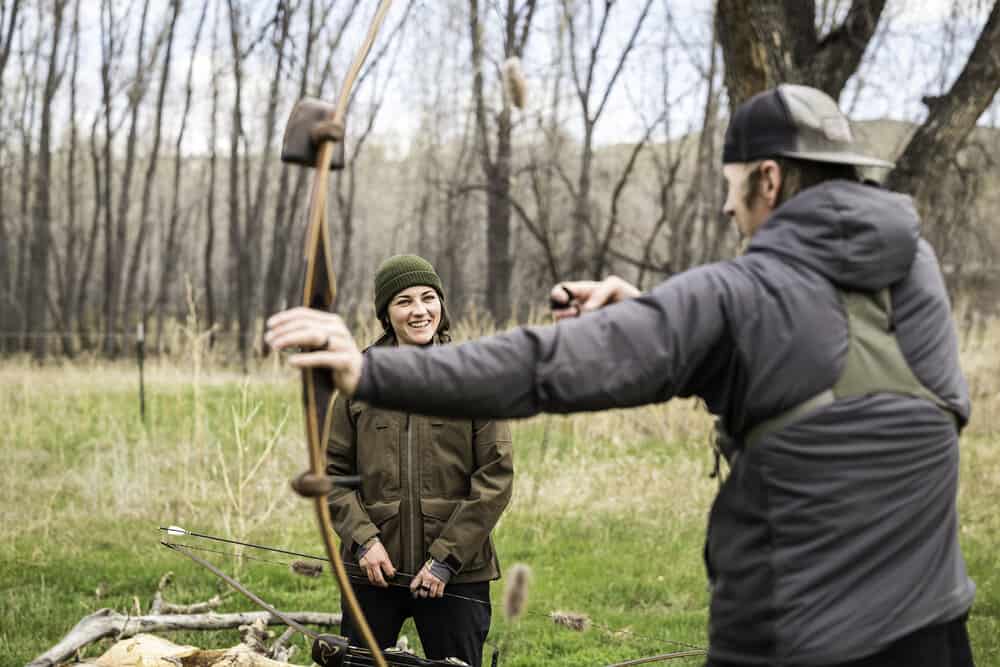
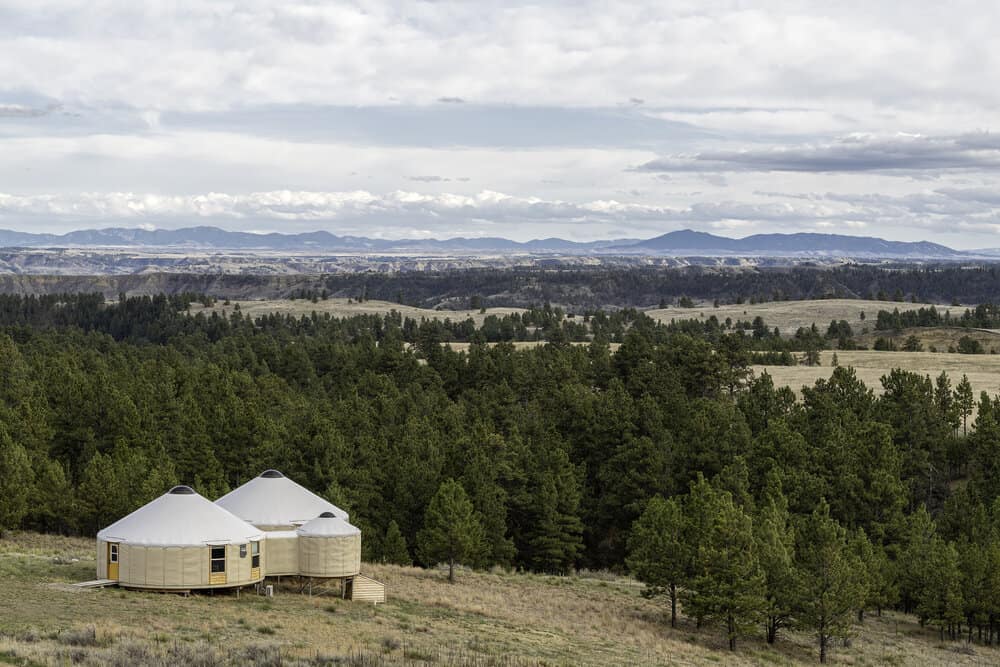
To go from entry-level archery to committing to an out-of-state traditional bow hunt was like going from the kiddie pool to the deep end. Most traditional bowhunters take shots from 20 yards or less, and I’d never even been 20 yards from a mule deer during the hunting season. However, there was something about Ryan’s invitation that I couldn’t deny or second guess. I remember answering him with a doubtless “yes,” and then struggling to catch up to what I’d just committed to. A few days later my head caught up with my soul, and I reconciled that I’d never learned anything important in any other way besides being thrown in, so the hunt was a go.
We used the town of Bozeman, Montana as a basecamp for the adventures of the season. Just to their north, along the Missouri River and the northern Montana border, the very ecology where Lewis and Clark and John James Audobon began the modern storytelling of the Great Plains and the American West, is one of the most experimental 20th-century conservation projects on the globe: The American Prairie Reserve. Unless you live in Montana, or know about the legendary bucks and bulls that come out of the Missouri Breaks region, you’ve likely never heard of it. The prairie begins in the rain shadow of the Rocky Mountains, where ocean-like expanses of grasslands and agriculture begin to stretch their way across the West.

For most of us, it is a forgotten landscape, even though it holds the history and biological diversity the American West was founded on.There’s a reason no one talks about the prairie. When the national parks and public lands of the West were being established, federal agencies took a scenery-based approach, rather than an ecology-based one. Our vast and dramatic mountain ranges, and iconic canyons and badlands, were turned into national parks and monuments. This affinity for drama in the landscape resulted in the prairie and its more subtle contribution to biodiversity being overlooked, leaving most of it unprotected from development and agriculture. Partially as a result, today grasslands are recognized by conservation biologists as one of the most under-preserved ecologies in the world. Though most efforts to federally preserve these places were thwarted over the years, there was notable success in northern Montana in 1936 with the Charles Russell Wildlife Refuge, and in 2001 with the Missouri Breaks National Monument, making this the best candidate for rewilding and northern Great Plains restoration.
Recognizing this, in 2004, a group of folks started working on The American Prairie Reserve, a non-profit organization designed to restore this grassland ecosystem. Their idea was to to strategically stitch together established public lands, native reservations and monuments with purchased private land in order to maximize habitat. Using this vast mosaic strategy, the goal is to create a three-million acre reserve for the grassland ecosystem to thrive. This is the area of land biologists have determined is required to create a fully functioning ecosystem with migration corridors and all native wildlife. Today, the combined total of owned and leased land managed by the reserve is well over 400,000 acres. In 2015, they successfully reintroduced bison, who used to number in the millions on the grasslands, and are focusing on keystone and at-risk species like prairie dogs, swift fox, black-footed ferrets, big cats, grassland birds, and pronghorn.
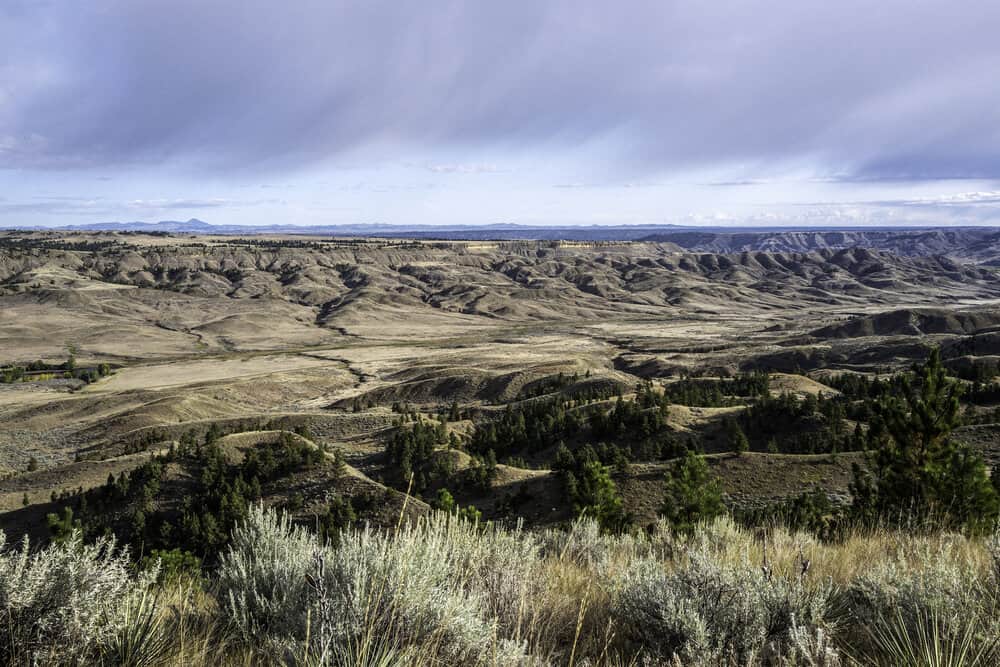
Unlike most land conservation projects, the American Prairie Reserve is accessible to the public and passable for access to any public land it is connected to. Even more rare is that they believe in hunting as a core aspect of the land management ethos. Because of this important legacy and timely regional experiment for the future of our biodiversity in North America, this is where our traditional bow hunt was planned. The first task of the project was to connect with bowyer Buddy Gould of Poison Dart Bows to design and craft the longbows we’d be using for our hunt. My initial call with Buddy to go over the basics was over an hour long, and I learned in that one conversation how special the tribe was that I was about to join.
The traditional bow hunting crowd was a whole new breed of hunters, and I felt their kindness and welcome immediately. Soon after I got on the phone with master archery instructor Tom Clum, whose online course I’d be taking to learn how to shoot, the same thing happened. What I had planned on as being a quick chat with Tom ended up a lengthy discussion about hunting, why we’d each come to it, and the journey I was about to begin. For those of us that don’t have it in our family heritage, invitations and forms of acceptance from others are critical, and sometimes hard to find. They are the permission and the belonging that we need in order to bravely enter the territory. With such solid support, I joined Ryan on the project with hope, and began to put the pieces together for how I’d get ready for our hunt over the next five months.
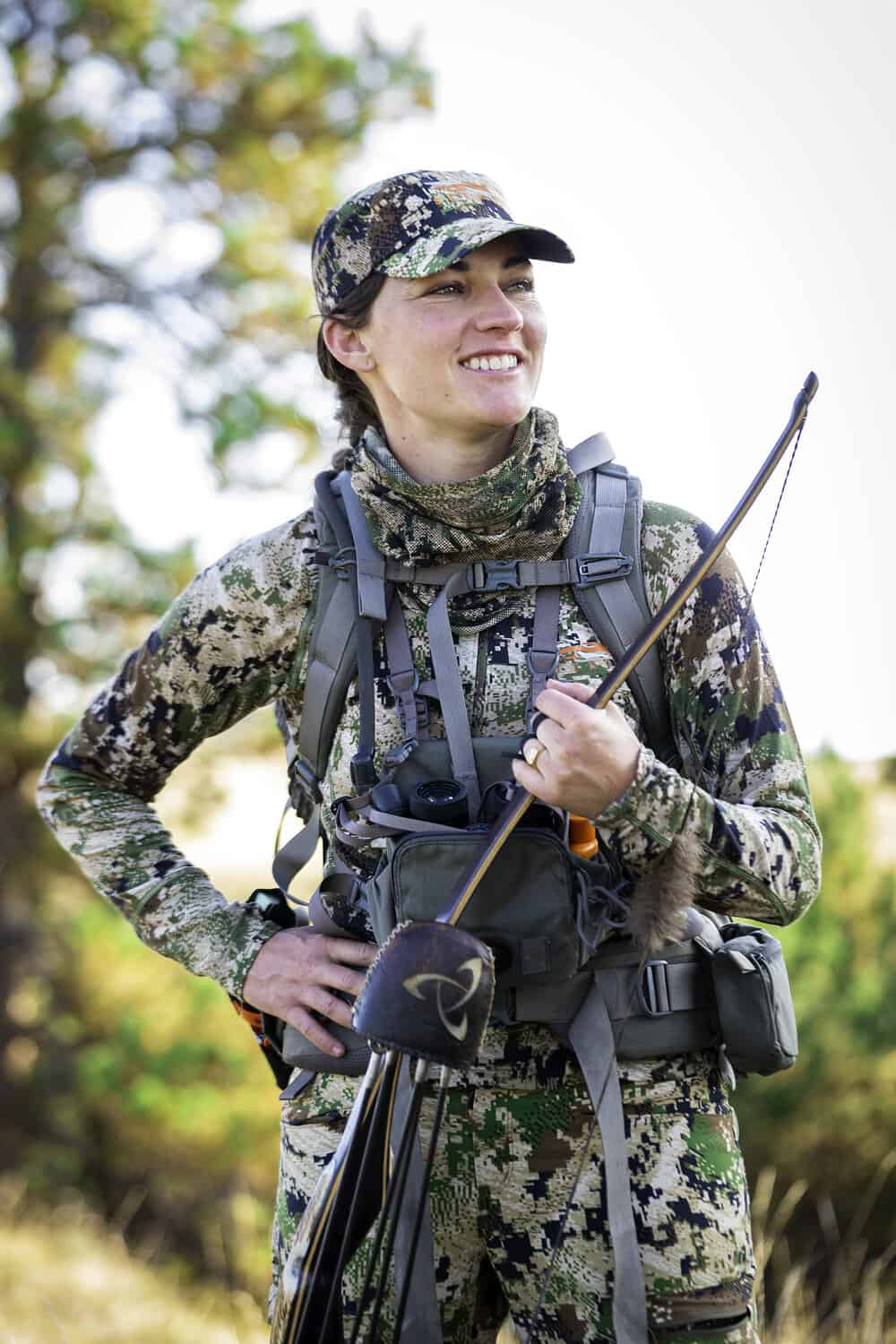
When Ryan and I received our bows from Buddy, we were astounded by their beauty. The craftsmanship was something to marvel at. Each bow was made with several different woods, presenting unique richness and color, and mine was adorned with elk antler. They were true works of art, evoking the romanticism one would imagine with a traditional tool.
We planned a spring rendezvous on the American Prairie Reserve with the full crew, including Tyler Sharp from Modern Huntsman. We wanted to scout the terrain, meet with the staff, and learn about the landscape we’d be immersing ourselves in. We made our way through remote northern Montana, and as we drove toward the yurts we were staying in, I was awestruck by the transition of gentle agricultural flatlands that turned into high bluffs and dunes as we descended toward Judith Landing, a historical site where the first dinosaur skeleton in the Western Hemisphere was discovered. At the bottom, cottonwoods and the Missouri river revealed verdant bottomlands and riparian habitat. Already, the land had a perplexing story to tell.
We’d spend the next few days exploring the terrain and its history while the staff of the American Prairie Reserve shared their vision and dedication to restoring the ecosystem with us. The habitat below our feet was the short grass prairie, where thick root mats create a soft and rich ecosystem 12 inches down. We were standing on one of the only unplowed sections of the reserve, where the native grasses had never been disturbed by livestock and machinery. I imagined how thousands of bison had shaped the very ground I stood on as they told stories about the Lewis and Clark expeditions and began to feel the legacy in the landscape. The oceans of grasslands were patterned with yucca and cacti. I was surprised at how the desert-like environment would shift to reveal ephemeral seeps and springs filled with wildflowers. As we moved through the reserve, we saw eagles, elk, coyotes, whitetail, pheasants, hawks, geese, prairie dogs, frogs and turkeys among the limestone cliffs and patches of pines. Ryan and I would shoot our bows back at camp, both of us getting familiar with the sensation of trying to draw a heavy string back and release with precision. Throughout our time on the reserve, we didn’t see a single mule deer. It started to sink in just how special it was to spend time on this landscape, and just how difficult it was going to be to hunt this open country.
I spent the next four months back home, wielding my bow in my backyard amidst chickens and at the indoor range near my house. As a student of Tom’s online archery mechanics course, I spent hours at my desk, watching each training module to learn the composition of a good shot sequence. After each segment, I’d walk outside and try to integrate what I’d learned into my form. The irony of learning a traditional skill online wasn’t lost on me; this is modern hunting.Progress was slow. Truthfully, I wasn’t comfortable being more than 10 yards from the target. Every time I expanded my range, I’d start missing, and lodging my pricey arrows into my fence posts. It started to sink in just how much I may have underestimated my ability to learn how to shoot this bow in time for our hunt, and just how difficult it was going to be to shoot at an ethical distance. But, I kept at it. The large and ever-present bruise on my forearm from the slap of the bowstring as I adjusted my shot became a part of me. The bruise became a tattoo of my commitment to our hunt, and a daily reminder that I had work to do. The Utah archery season was fast approaching. I trained and stayed focused, but I began to feel a building anxiety. In a previous year of rifle mule deer hunting, I’d learned the hard way about a ‘shot gone wrong.’ Though it worked out in the end, the lessons of a multi-shot takedown drawn out over a long period of time with immense tracking and spotting skills needed to close the hunt was burned into my memory. Had I not been with my friend and mentor Jon Chatelain, I would have lost that animal. Jon was excited to hunt the archery opener together this year, and we’d been planning it for months. With two weeks to go, I called him in a panic, and told him not to come with me.
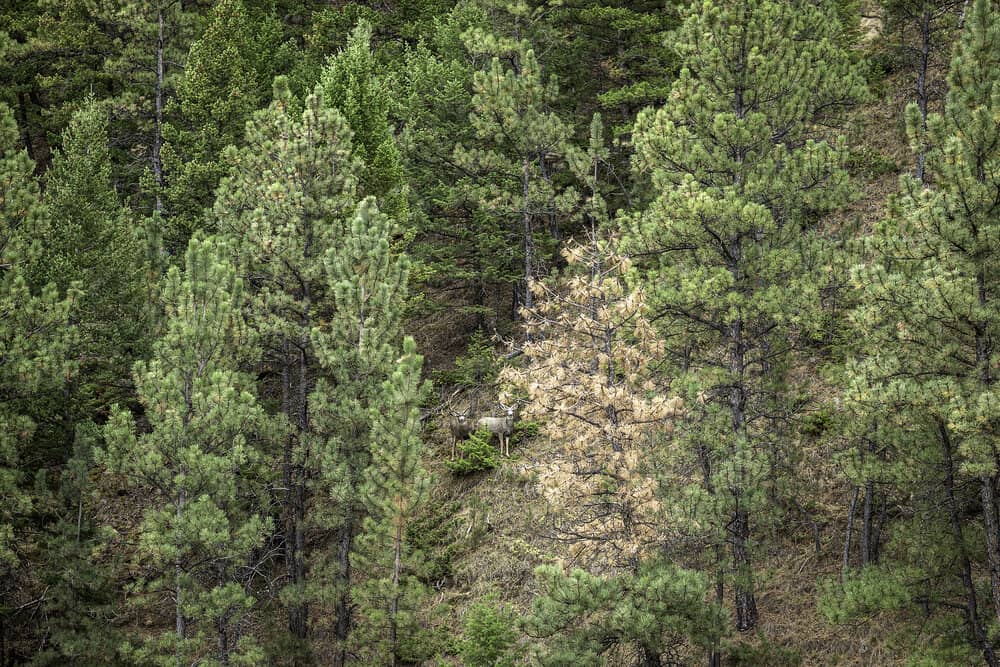
As a hunter for 25 years, he’d already worked through the trials of being a beginner, and I didn’t want him to have to relive his mistakes in mine. I feared I’d wound or lose an animal and send us on a long, extended journey. Over a whiskey, Jon talked me down. He reminded me that even with years of experience, bad shots happen. However painful to accept, wounding animals is a part of hunting, especially bow hunting, that we have to prepare for. It was in talking with Jon that I accepted mistakes as an inevitable aspect of hunting no matter how long you’ve been at it. The lifelong skill is doing what you can to minimize them, and learning how to respond when they happen. I realized it was my job to decide when I was ready. In hunting you are the only one who can walk out into the landscape with the essential conviction to pursue an animal. Later in the season, Ryan would explain something similar to me — that you have to be actively pursuing the animal in your mind. You have to know that you have the skills to pull it off. You can’t be entertaining self-doubt in your accuracy, or any of the other aspects of your preparedness
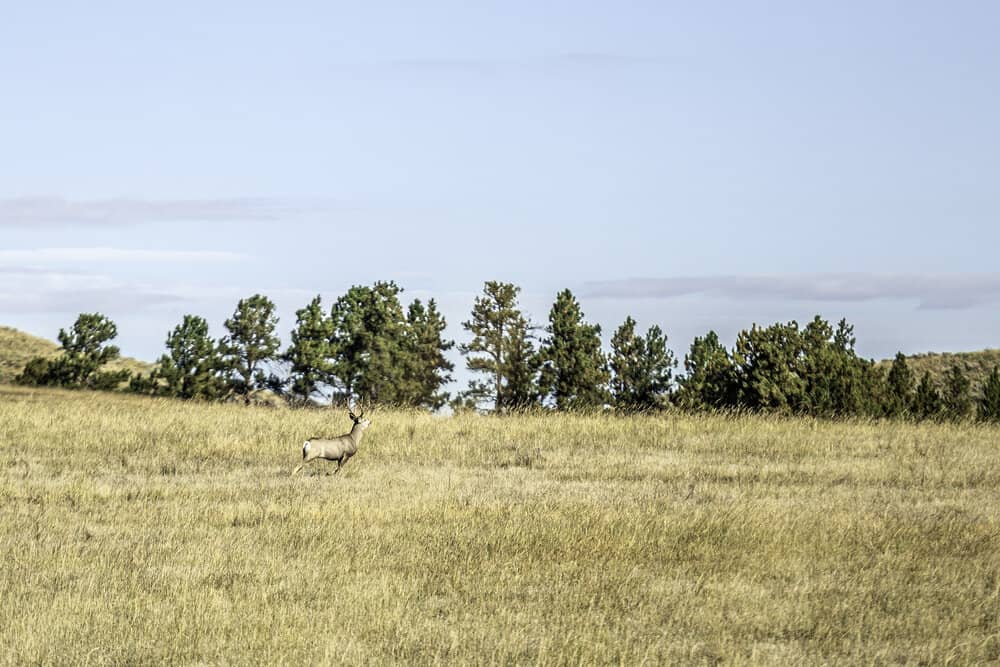
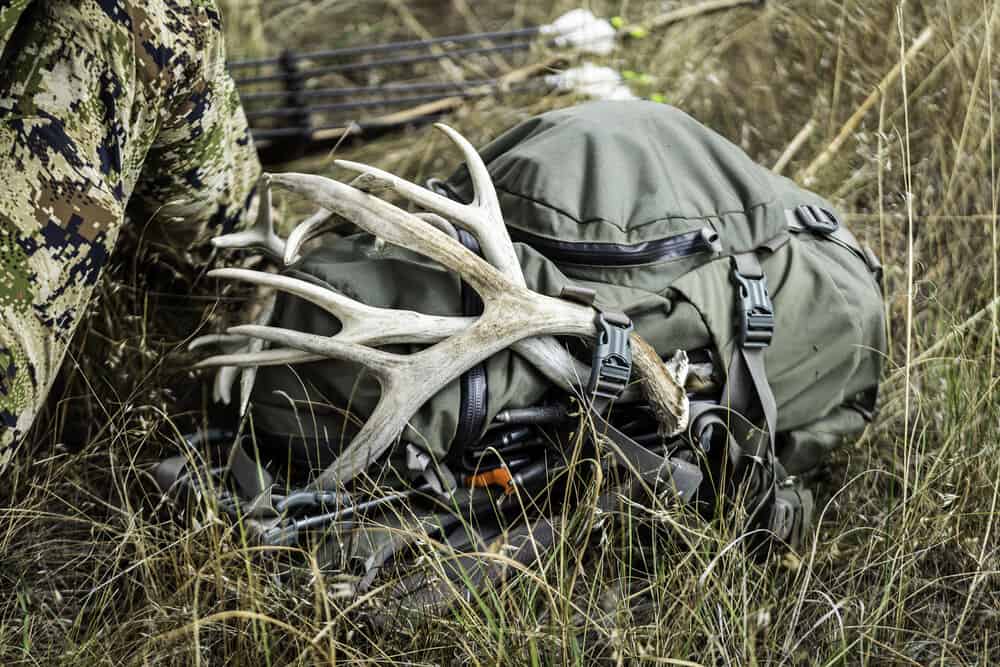
The Utah season came and went, but not without its introduction to the nuances of the traditional bow. I got familiar moving through the forest with it, and the bow began to feel like a part of me, as a fly rod does moving through the willows. The building love and frustration of our relationship continued, when bucks even 40 yards away weren’t close enough. Back home, I swapped broadheads for field points. With just three weeks until our hunt, I wielded the bow daily. I’d pick it up, feel the tension between my shoulder blades, and release into a foam target, again and again and again. Finally, it was time to test our instincts after five months of work and focus. Ryan, Tyler and I rendezvoused in Montana to begin our trek to the American Prairie Reserve.
It was dark when we finally got to the cattle guards and gateways of the Missouri River. Brake lights suddenly painted the dark night as we stopped to observe a beautiful three-point buck along the roadside, guiding our way in. We proceeded to see not one, but two handsome bucks and a majestic breaks bull elk. Having not seen any mule deer earlier that spring, I began to feel like we actually had a chance at this hunt. We spent the next four days with the yurts as our second basecamp, exploring the prairie. Coming from an urban environment, it is always so special to walk out the front door and start hunting. In the mornings, we’d find where the edge of the pines met the open expanse of rolling grasslands to spy the terrain, and sit as the sky turned from a hazey strawberry to orange. We found beautiful, mature bucks every day. I learned the process of spot and stalk on the prairie. With few landmarks, you work to pop out in just the right spot in the tall grass, and practice taking your shoes off to stalk in silence at just the right time. It’s hard to describe what it feels like to go lightly — to be in your socks, bow in hand, all senses heightened, sneaking up on a wild animal at close range. Everything matters.
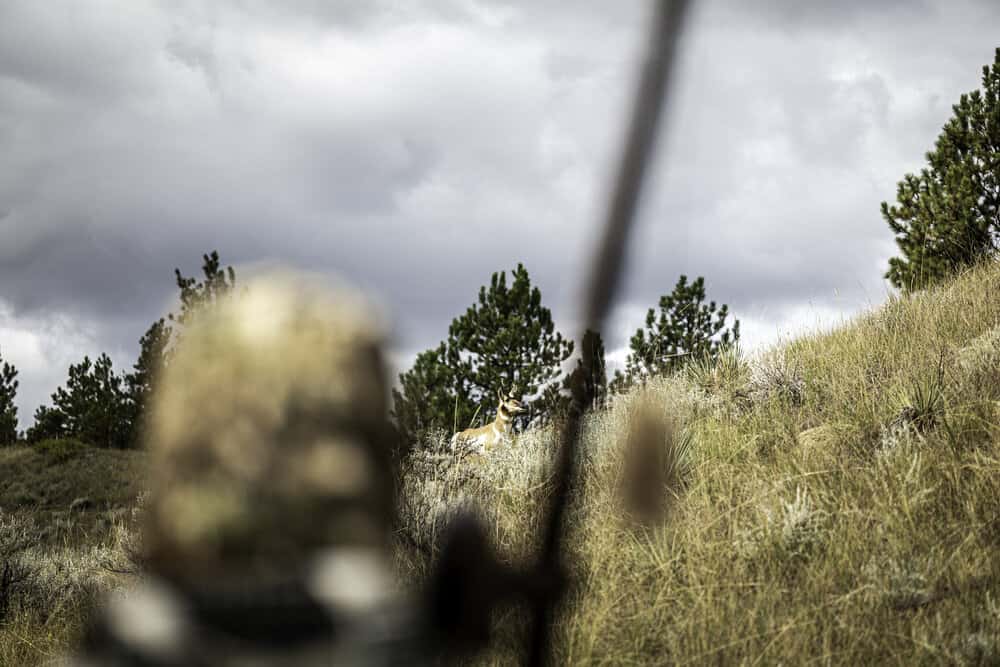
After just one day of being out, we’d all come close to shooting a buck. Ryan had closed in to 20 yards on his before the wind switched, and Tyler and I had crept so close to a bedded buck before a small herd of antelope gave us away. We were all so alive with these intimate animal encounters this early in our hunt. It was the most fun I’d ever had hunting. I felt so connected hunting at close range, playing the wind and stalking barefoot through the prairie with my bow in hand — an experience specific to archery. It’s thrilling to build intimacy with these animals and pit your skills and awareness against theirs to understand just how keen and sensitive they are, and just how unforgiving the elements can be.This pattern of finding beautiful mature bucks and getting close went on for days as we explored the nuances of the prairie’s habitat. The edge of the grasslands would drop off into cottonwood-filled canyon below us, and we’d find ourselves in lush zones filled with deer sign, where the leaves were rich with fall tones among sage, juniper and pine. Each day of hunting was better than the last. Often, we’d spot Ryan in front of us in his socks, stalking in on a buck.
Multiple times, he got to 12 yards before the wind switched and gave him away. I began to crave these opportunities to get close, observe their behavior, and test my instincts on the land. We navigated the reserve, looking for north-facing forested zones amidst the open expanses of grasslands and limestone dunes that we knew would hold deer. We’d find areas where almost every pine around us was raked by mule deer, and dripping with sap. As we crept along the ridgelines, I started to notice shed antlers everywhere. They were so large I’d spot them from across the canyon and plot my course for their retrieval. This was the most active mule deer habitat I’d ever been in. One day, we found so many I could barely carry another on my pack. The sheds became part of the game of hide and seek were were playing with these amazing deer, their size a kind of historical authority of what it meant to be a wild animal in that ecosystem. Each day, we counted how many deer we might have killed had we been using any other weapon than a traditional bow. It was in the dozens. Halfway through the week, we woke up to rain, and it was clear we had some weather moving in. The softened ground was welcome, but the farther we walked, the more mud began to build up on our boots.
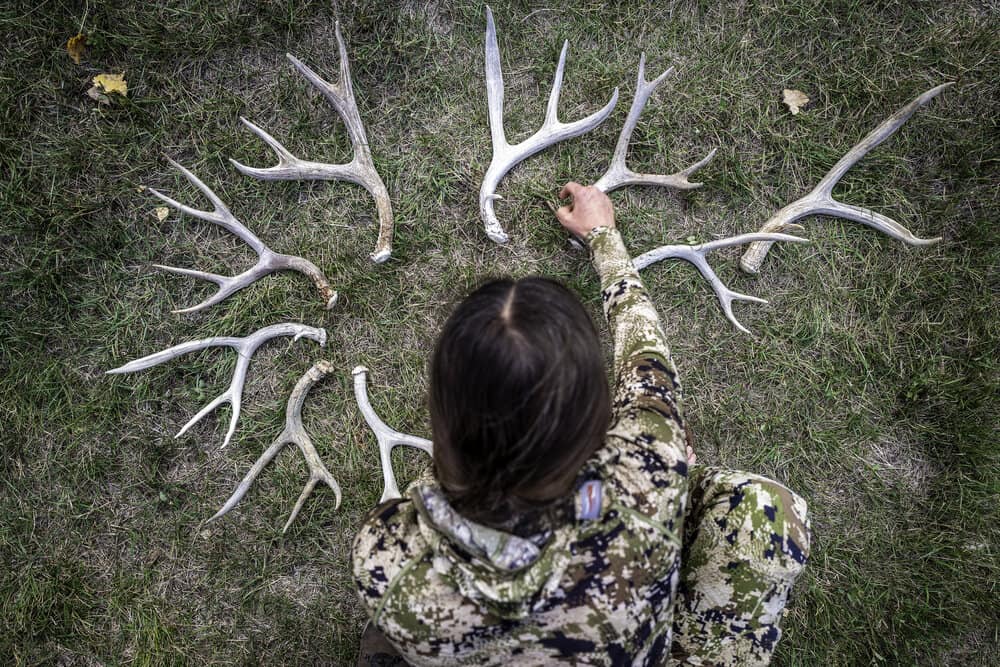
On our way back to the yurts, soaking wet, Ryan uttered the simple and unwavering words, “We have to go.” For a few moments, I considered staying on my own, but Ryan’s tone was sobering. He reminded me about the unguarded bridge we had to drive over to get out, and gave me a quick schooling on the severity of Missouri Breaks gumbo and the impending snowstorm. Convinced and heartbroken, I packed up, and we were on the road within 15 minutes. By the time we started driving out, both of our trucks were fishtailing in the thick mud on a very gentle grade. It was jarring to have the hunt I’d looked forward to and trained for for so long end in almost an instant. Our weather window had been slammed shut on a hunt we were only halfway through, and making progress with. But I learned two important lessons that day — you have to hunt hard while the weather is on your side, and to take the mud in the Missouri Breaks seriously. Of the millions of registered hunters in the U.S, less than 10% are archery hunters, and less than 20% of archery hunters use a traditional bow. It is by no means a common path. Some begin their journey because they’re led to that level of challenge. Others see it as the highest expression of Fair Chase, because you are moving and breathing well within an animal’s detection distance. I went into the season without expectations or a plan for how long I would use it. Admittedly, after the first few weeks of having bucks at 40 yards that I couldn’t release an arrow at, I thought about how I wanted to spend the winter training with a compound bow to extend my shot. I’m learning you have to let those experiences go in this short-range game of traditional bow hunting.
My bow is hanging up at home now. The shed antlers — symbols of growth and adaptation — adorn my shelves as the trophies of our time on the American Prairie Reserve. The pressure of the season is subsiding, and I remain curious. Deep down, I know the prairie, the struggle stick and I have unfinished business. We have a mystery to unravel together, perhaps next season or a decade from now. The end of our time in Montana was just the beginning of a long-term journey with traditional archery, as any true craft in woodsmanship should be. Hunting with a traditional bow has led me down a path of examining why I hunt, and what I’m willing to dedicate to it. I’m interested in the type of hunters traditional archery attracts, their approach, and the reverent and humbled narrative worn into their perspectives by their trials in the field. My sustained tenacity after an unsuccessful season and hundreds of hours of training and practice shows me I have more to discover — in the craft, the community, the landscape, and myself. Archery has unearthed a new complexity and joy alongside an honest look at where I have work to do as a hunter. I’ve learned more about the intricacies of wildlife this year through choosing the stick-and-string path than any other season. The bow has become a test of instinct, of commitment and of intuition, and I long to let an arrow fly.